One of the best developed and engineered cars from the British Motor Corporation (BMC) in many years, the Austin 3 Litre saloon deserved better sales and a more appreciative legacy
Words and photography by Quinton Taylor, Neil Hogg, John Vevers, and NZCC archives
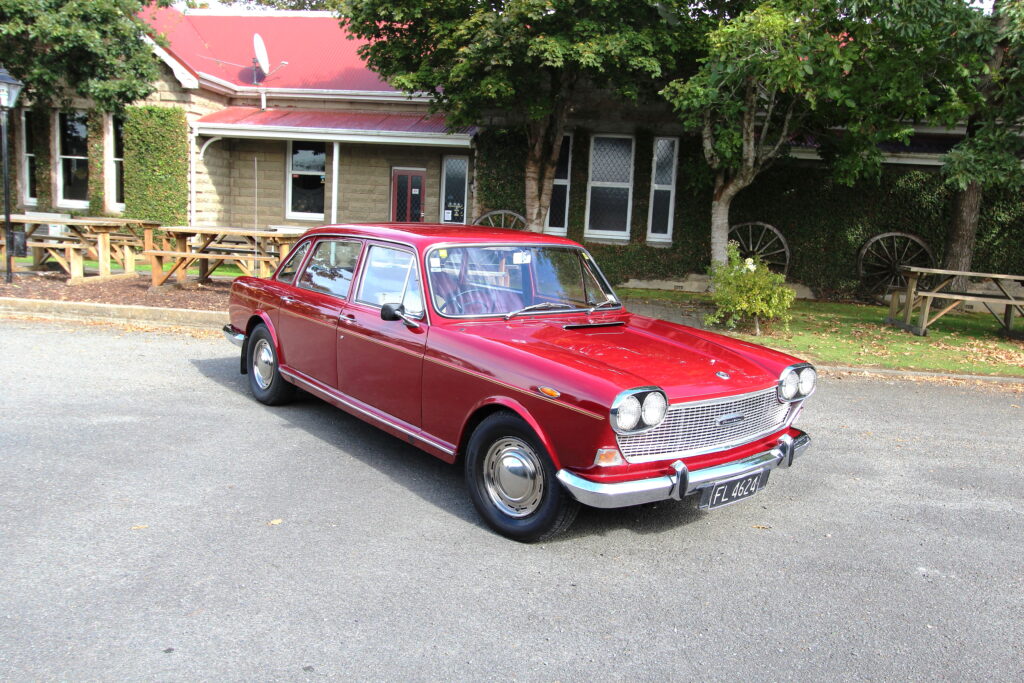
Once you have driven one of these cars, which Rolls-Royce seriously considered as the basis for a new model, it’s hard to fathom why they weren’t more popular. From the safety of what was a more egalitarian New Zealand at the time, it’s tempting to think that, despite Austin having made substantial vehicles before, including 1927’s 3.4-litre Austin Twenty and the Westminsters of the late ’50s, it had hit a glass ceiling. Its success with small and cheap cars — even though, like both the Mini and the Maxi, they were often innovative — had redefined the brand. Not to put too fine a point on it, snobbery has always been a feature of many car markets, and buyers of upmarket cars inevitably preferred a Rover, Triumph, Jaguar, or Mercedes badge on their bonnets.
As a result, survivors from a production run of just 9993 cars from 1967 to 1971 are quite rare. Many people, upon seeing an example on our roads, would struggle to name it, although the lines will look familiar. Around 300 to 350 were imported to New Zealand in the 1970s. It’s a tribute to the fondness engendered among their owners, and perhaps their build quality, that a surprising proportion are still either roadworthy or would take very little to get running again. They also keep turning up in surprising places.
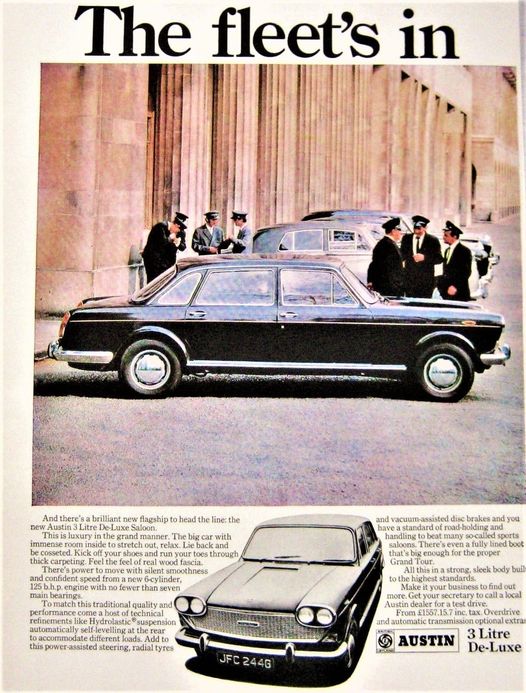
First impressions
Owners are a loyal bunch. Helensville’s John Vevers heads a group dedicated to the cars — the Austin 3L Register of New Zealand. Like many members, John and his wife own several of these British luxury cruisers.
“They were born unloved into the British Leyland family, yet they are extremely reliable. There are about another 35 left in New Zealand that would not take too much to get running.”
British engineer Neil Kidby experienced his first 3 Litre saloon around 1976, when the garage where he was serving his apprenticeship received one from a UK company fleet for servicing.
“I can clearly remember the Persian Blue automatic 3 Litre and my youthful bewilderment upon looking at the suspension — although this bewilderment did seem to be shared with most of the senior members of the workshop staff.”
The car featured the most sophisticated version of the hydrolastic suspension developed for the ADO16 Austin Morris 1100.
Since that day, Neil has formed a strong affinity for the cars in his collection. In January 1996 he formed the UK Austin 3-Litre Owners Club, which enjoys a healthy membership and now has a bi-monthly newsletter and website. Neil also wrote the bible on these cars, The Story of the Austin 3 Litre, and has visited members in New Zealand.
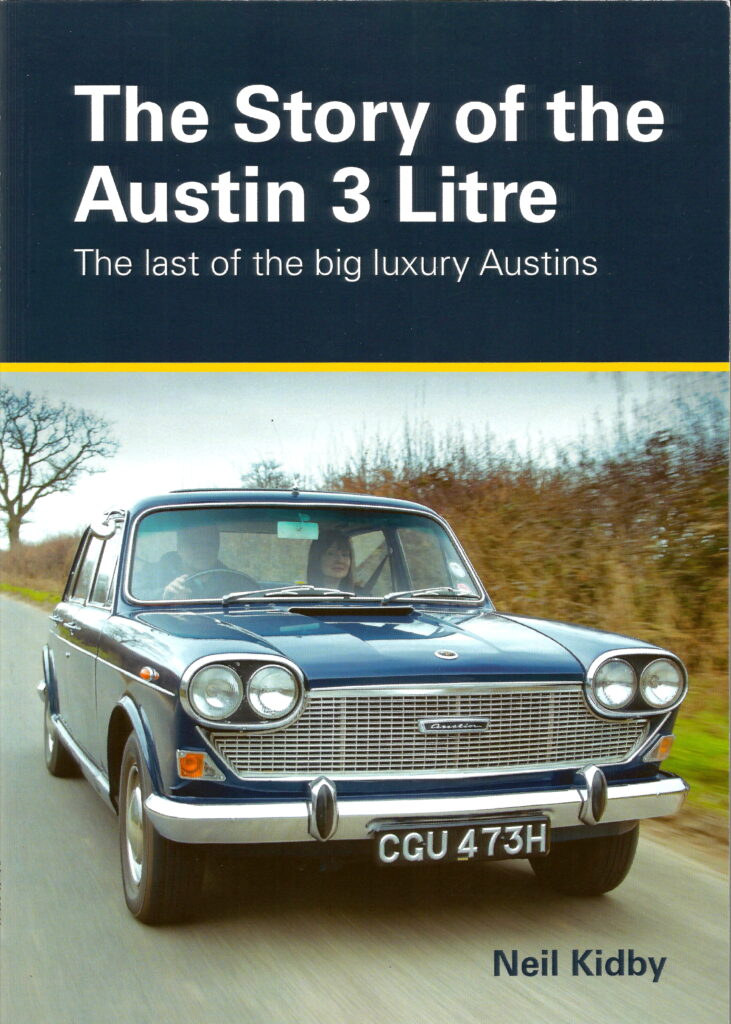
First impressions
Owners are a loyal bunch. Helensville’s John Vevers heads a group dedicated to the cars — the Austin 3L Register of New Zealand. Like many members, John and his wife own several of these British luxury cruisers.
“They were born unloved into the British Leyland family, yet they are extremely reliable. There are about another 35 left in New Zealand that would not take too much to get running.”
British engineer Neil Kidby experienced his first 3 Litre saloon around 1976, when the garage where he was serving his apprenticeship received one from a UK company fleet for servicing.
“I can clearly remember the Persian Blue automatic 3 Litre and my youthful bewilderment upon looking at the suspension — although this bewilderment did seem to be shared with most of the senior members of the workshop staff.”
The car featured the most sophisticated version of the hydrolastic suspension developed for the ADO16 Austin Morris 1100.
Since that day, Neil has formed a strong affinity for the cars in his collection. In January 1996 he formed the UK Austin 3-Litre Owners Club, which enjoys a healthy membership and now has a bi-monthly newsletter and website. Neil also wrote the bible on these cars, The Story of the Austin 3 Litre, and has visited members in New Zealand.
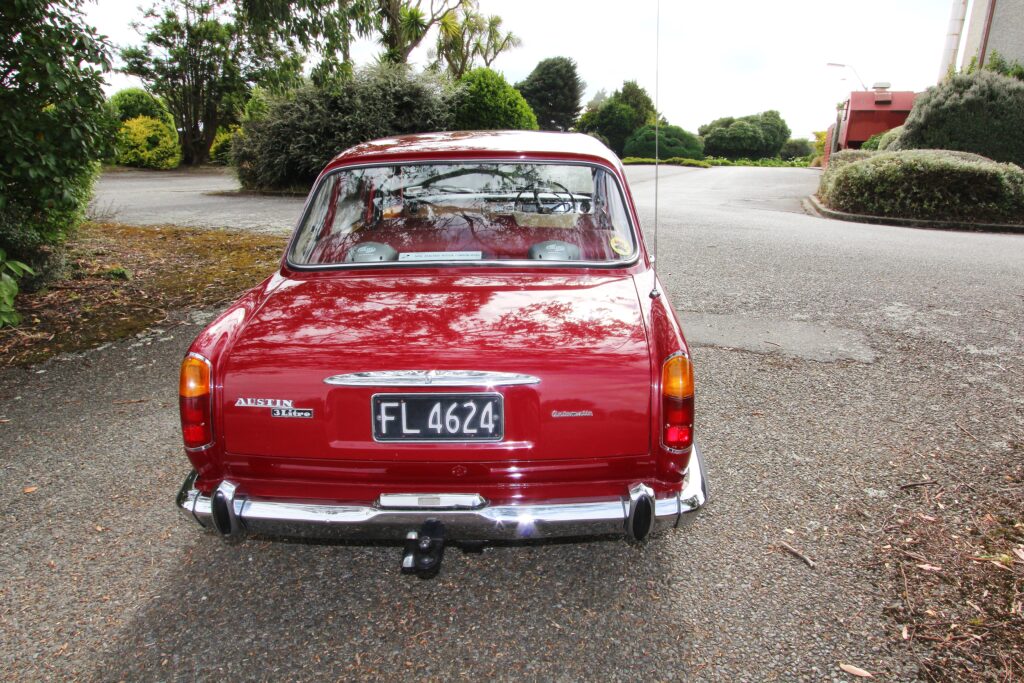
Rolls-Royce ride
Working closely with Rolls-Royce since 1961, BMC sought to develop a smaller car utilising the Austin 110 / Princess Vanden Plas body for a Bentley Java project, which was discontinued in 1962. Note that Rolls-Royce had previously supplied its four-litre alloy six-cylinder engine for the 1964 Vanden Plas Princess 4 Litre R, which used a heavily revised Austin Westminster 110 body; 6555 of these cars were built. Rolls-Royce went as far as clay mock-ups using an adapted ADO61 bodyshell for the second try at the Rolls-Royce Rangoon and Bentley Bengal projects. However, those projects never passed that stage.
From the original front coil springs and leaf springs of 1962, the design changed in 1966 to the radically new hydrolastic units used by the company’s 1100 to 1800 models. Dr Alex Moulton’s famous hydrolastic units were further developed to suit the heavier car. He also developed a self-levelling rear suspension. Moulton later said the units in the ADO61 body were the pinnacle of his hydrolastic suspension development.
By 1966, BLMC had three development Austin 3 Litre cars running. The bodyshells were extremely strong, although costly to make. Two Austin versions were built for testing and a third, with Wolseley trim, was fitted with a Rover V8. The latter proved very popular with staff. Others cars are thought to have been built using the Rover engine, and engineer Harry Webster ran his as a daily driver. Despite 158bhp (118kW) being available, a chassis that could handle it easily, and keen support among the engineers, the decision not to go ahead was another all-too-typical story of missed opportunity at BMC.
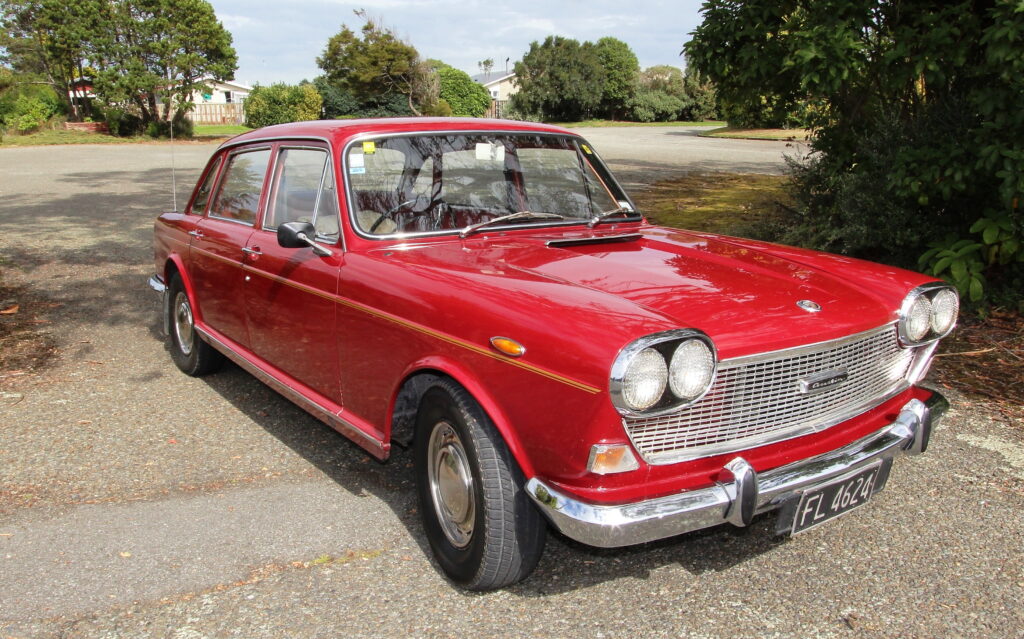
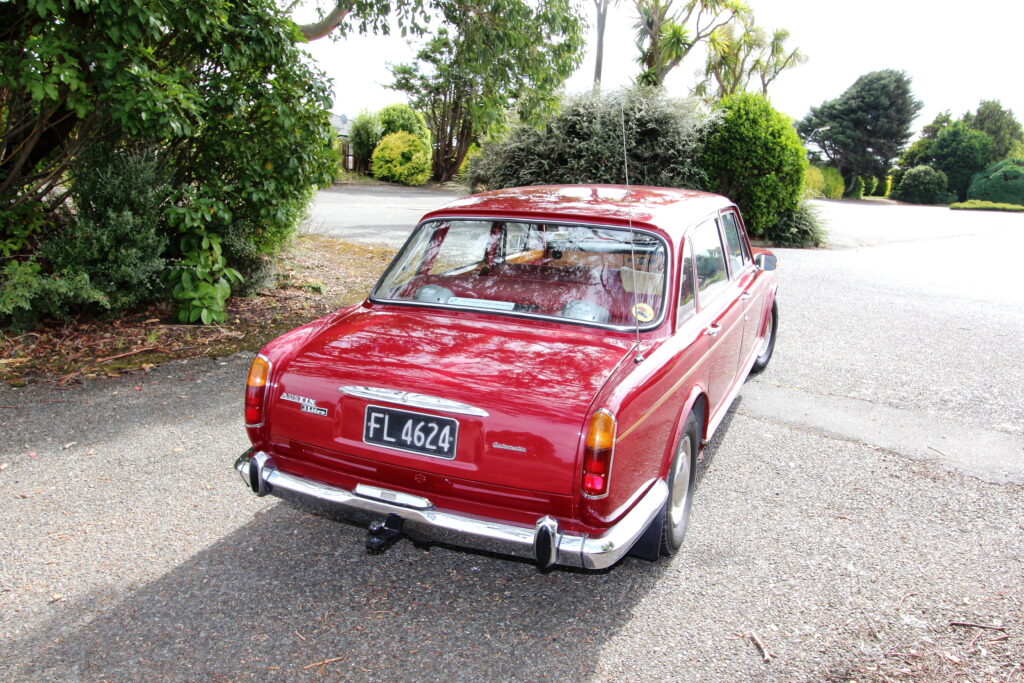
Jaguar beater
The standard model was finally readied for launch at the London Motor Show in 1967. A number of pre-production cars were supplied to customers for evaluation and generally these customers, and the press, liked the 3 Litre. Heavy fuel consumption was always a negative, but the car always earned praise for its outstanding ride quality and handling as well as the levels of finish and equipment — features that should have lifted the car’s image above that of its workaday brethren.
It soon became clear that the 3 Litre surpassed anything in its class for road holding and ride quality. In a special test course involving a number of cars, including Jaguar’s new XJ6, the 3 Litre outperformed the Jaguar in cornering. The 3 Litre was never intended as a performance car. It was positioned as an executive express, with the focus on its low noise levels, quality ride and handling, and luxury interior. The motor was the C-Series engine also fitted to the MGC but with a different camshaft, which developed less peaky horsepower than the MGC.
Upgraded production cars received twin headlights and opening quarter-light front windows but few cars were made available until 1968. By then, in comparison with the stylish and potent Triumph 2500 PI and Rover 3500, the cost-constrained 3 Litre definitely looked dated, and the front in particular was never elegant. In another of those classic near misses, Pininfarina’s Leonardo Fioravanti had drawn up a stunning aerodynamic replacement that really should have been the 3 Litre design. The designer of the 1966 Ferrari Dino 205, 1968 Ferrari 365 GTB/4 Daytona, and 1984 Testarossa eventually saw his design evolve into the Citroën GS. It would take Rover with its SD1 to finally build an ersatz version of Fioravanti’s work.
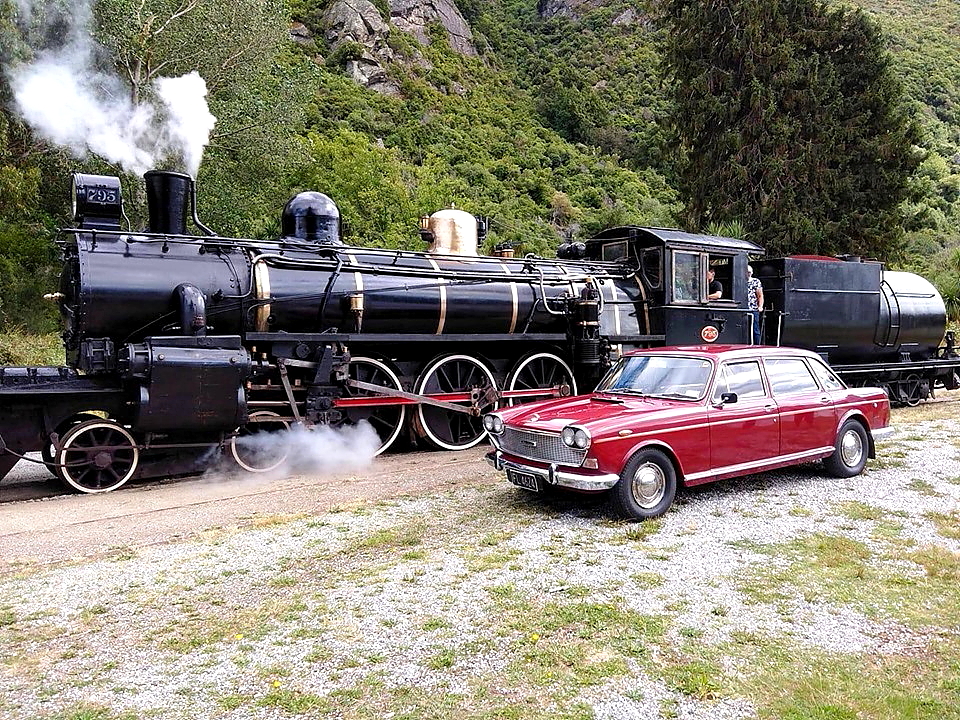
Family of five
Ignominiously overlooked, and aided by some jeering at its poor sales, the car has acquired a sad reputation over the years, which it doesn’t deserve. It was well put together, an impressively quiet cruiser, with that amazing handling many described as “like driving a big Mini”.
I eagerly accepted an offer to spend the day cruising with Neil and Karen Hogg of Invercargill in their very tidy 1971 example, one of five in their collection. They had a story to tell about their cars, as Neil explains.
“I was on Trade Me one day and saw this car advertised. My first car was an Austin 1800 and this was a similar shape so I thought I would buy this as a project. I bought it sight unseen. It was delivered here and I managed to drive it off the truck. That was the manual overdrive one, the blackberry one.”
That was six years ago. Two and a half years later the couple added to the collection from a Mosgiel car sales yard.
“It was a little pricey. About a year later we went back up and saw it was still there in the car yard for just $1000. He dropped the price again to $800 and then he said, ‘Oh by the way, there is one sitting in Bannockburn that goes with this. A guy traded an Armstrong Siddeley and the Austin’s been sitting up there for five years.’ We had already bought a parts car, which is sitting under a cover outside.”
Suddenly, their collection had grown to five.
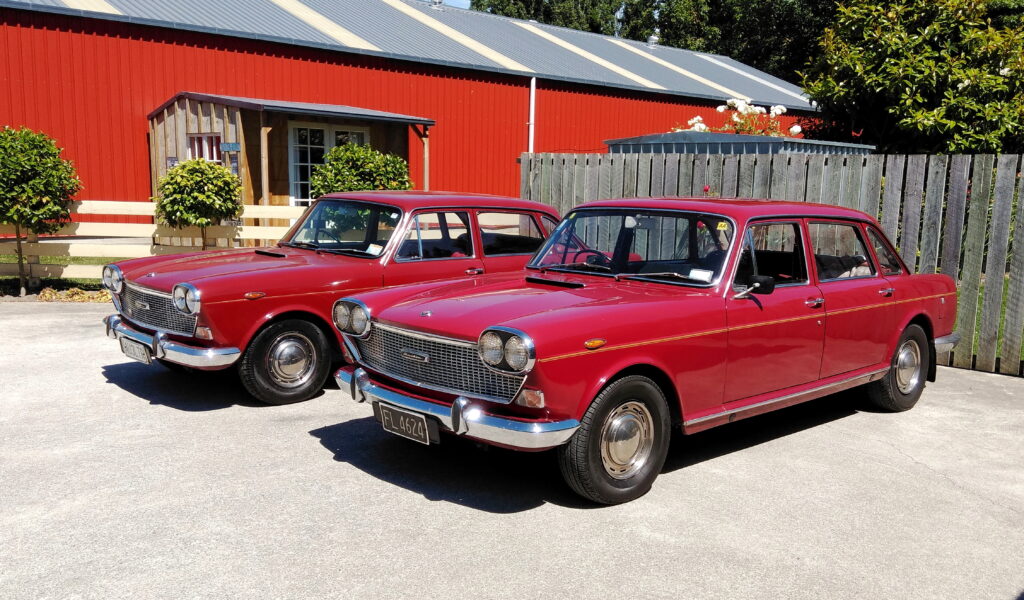
Off to the reunion
The Mosgiel car, the subject of this feature, was restored in 1997.
“Judging by some of the paperwork — I don’t know much about its history — I think it came from the Masterton area. Receipts show it spent some time in the North Island and then the West Coast at Greymouth. That was about five or six years before I got it from Bannockburn.”
In 2017, Neil and Karen drove to Puhoi, north of Auckland, for the Austin 3L Register reunion, a round trip of 2500 miles (4023km). The Austin performed faultlessly throughout the trip. It’s a trend of reliability continuing under their ownership — quite a feat for a now 50-year-old car. Open road cruising is its forte.
“It’s never really let us down. I put an electronic ignition in it before we went to the reunion as a bit of a safeguard and it’s been reliable. It cruises along nicely. It can be sluggish on the hills if you lose your momentum. They are not a big horsepower engine, just 124hp, but once you are cruising it likes doing 100–110kph. It’s one and half tons so it is heavy. I enjoy driving it and we will definitely be keeping it.”
The Hoggs are regulars on South Island car runs and at car shows, but Neil doesn’t think they will be returning to the North Island soon.
“It took $1500 worth of fuel on the reunion trip so it is getting up there. It averaged 20mpg so it’s not too bad.”
Austin 3 Litre saloons are a little thin on the ground in the South Island. There is one in Ashburton and another two in Drummond but they are not running and one is a parts car. A Christchurch owner has converted his car to Vanden Plas specifications and two-tone paint, a model which was the subject of a mock-up but never put into production at Cowley.
There was a lot to like about these cars and Neil readily admits being an enthusiast of the model.
“It’s very different. You can go to a car show down here and nobody else has got one.”
“And they are comfortable,” adds Karen.
As can be expected with older cars, they require some maintenance. The hydrolastic system used in these cars needs to be set up properly, but that attention rewards keen drivers, as Neil explains.
“It needs the rear [self-levelling] suspension done properly. You don’t slow up for corners — you just go for it through corners and it loves it.”
Surely if, 50 years ago, more people had experienced the ride that so impressed me just the other day in Neil and Karen’s Austin 3 Litre, these cars would have sold better than they did. In Damask Red, the feature car wafts along with an eerily smooth, quiet ride. Despite the large transmission tunnel to cater for the north/south transmission location, there is plenty of legroom for those sitting on the Ambla-clad armchairs. An abundance of wood trim adds to the air of luxury and, along with the fresh air system, there is the welcome detail of opening quarter-light windows.

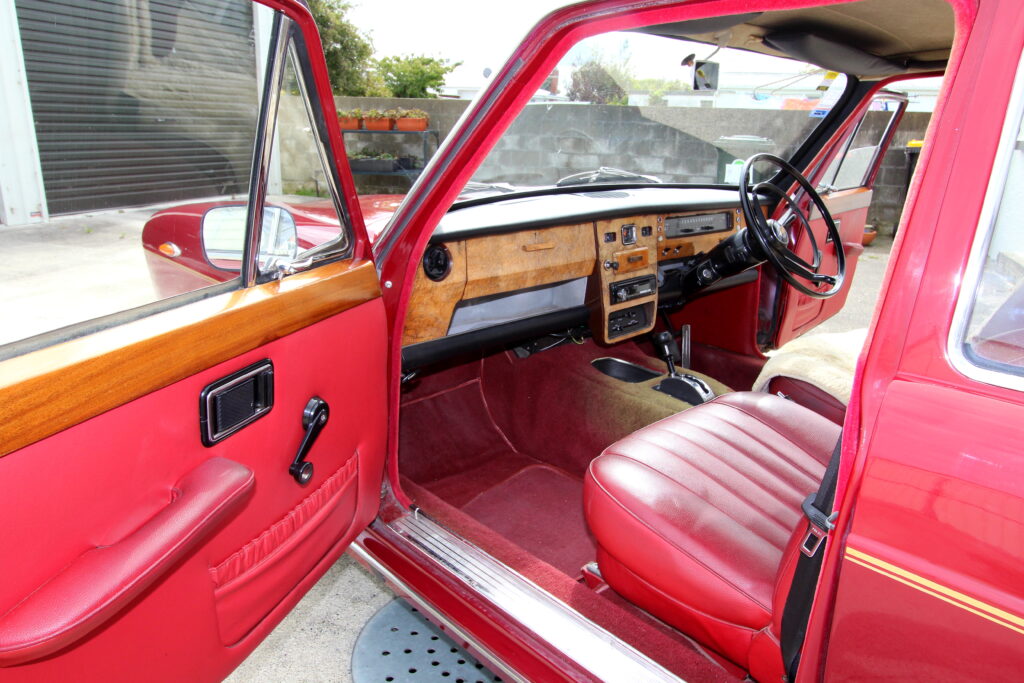
Last hurrah
The Austin 3 Litre saloon was the last luxury car to bear the Austin badge, the last rear-wheel-drive Austin, and the biggest car to receive hydrolastic suspension. A number were converted into ambulances, hearses, limousines, or estate cars by various coachbuilders. A few were retained by county police forces for highway patrol work. Unfortunately, being such a solidly constructed car, many succumbed to ‘banger’ racing, ending their days on the dirt tracks of the UK.
Now, in the right hands, the future is looking brighter for the surviving cars in New Zealand. The blue car in Neil’s collection came from Temuka. The intention was to drive it back to Invercargill but a petrol leak and some other issues made shipping it advisable; it now waits its turn for attention.
Meanwhile, Neil is eying a future that was denied the model in its production years. In light of the factory’s enthusiasm for a Rover V8 version, Neil is tempted to put a Rover V8 in the grey car in his collection. Creating a great-handling, spacious, luxury car with old-fashioned quality and modern levels of comfort and performance, on top of its rarity, would surely help more people see these Austins in a new and more deserving light.
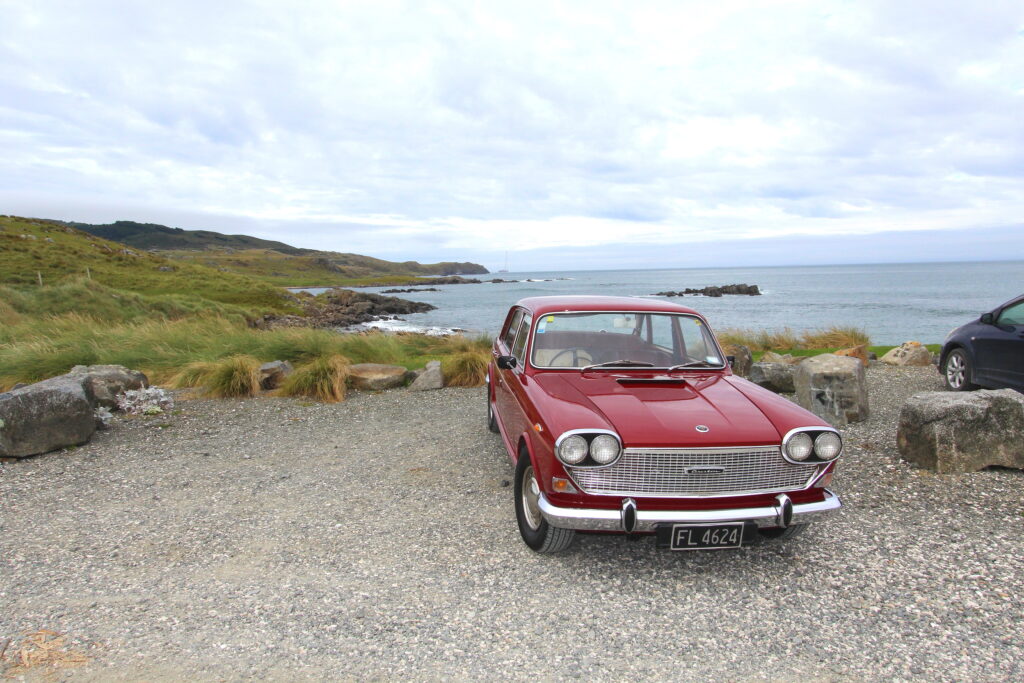
AUSTIN 3 LITRE SALOON
Engine: In-line six-cylinder, seven main bearing, cast iron block
Capacity: 2912cc (177ci)
Valves: Two per cylinder, single side-mounted camshaft
Compression ratio: 8.2:1
Fuel system: Twin SU HS6 carburettors — redesign of the C-Series engine and also used in the MGC sports car)
Bore/Stroke: 3.28in (83.3mm)/3.5in (88.9mm)
Max. power: 124bhp (92.5kW) @4750rpm
Max. torque: 163ft·lbs (221Nm) @ 2700rpm
Transmission: Four-speed manual (optional overdrive) or 3-speed BorgWarner 35 automatic
Steering: Cam gears, rack & pinion, power-assisted
Brakes: Girling power-assisted 10.4-inch; disc front, drum rear
Suspension F/R: Independent all-round; (F) hydrolastic units interconnected with rear suspension; (R) hydrolastic suspension units, trailing arms, and self-levelling rams with engine-powered pump
Wheels: Pressed steel 14-inch rims fitted with Dunlop SP41, 185 x 14 radial tyres
Dimensions
Length: 15ft 5.7in (472cm)
Width: 5ft 6.75in (169.5cm)
Wheelbase: 9ft 6.5in (291cm)
Track F/R: 4ft 8.25in (143cm)/ 4ft 8.0in (142cm)
Weight: 3304lb (1500kg)
Manufactured:1967–1971 (Cowley, England) ADO16
Performance
Maximum speed: 100mph (161kph)
0–60mph (0–96.5kph): 15.6sec
Standing quarter-mile: 21.2sec
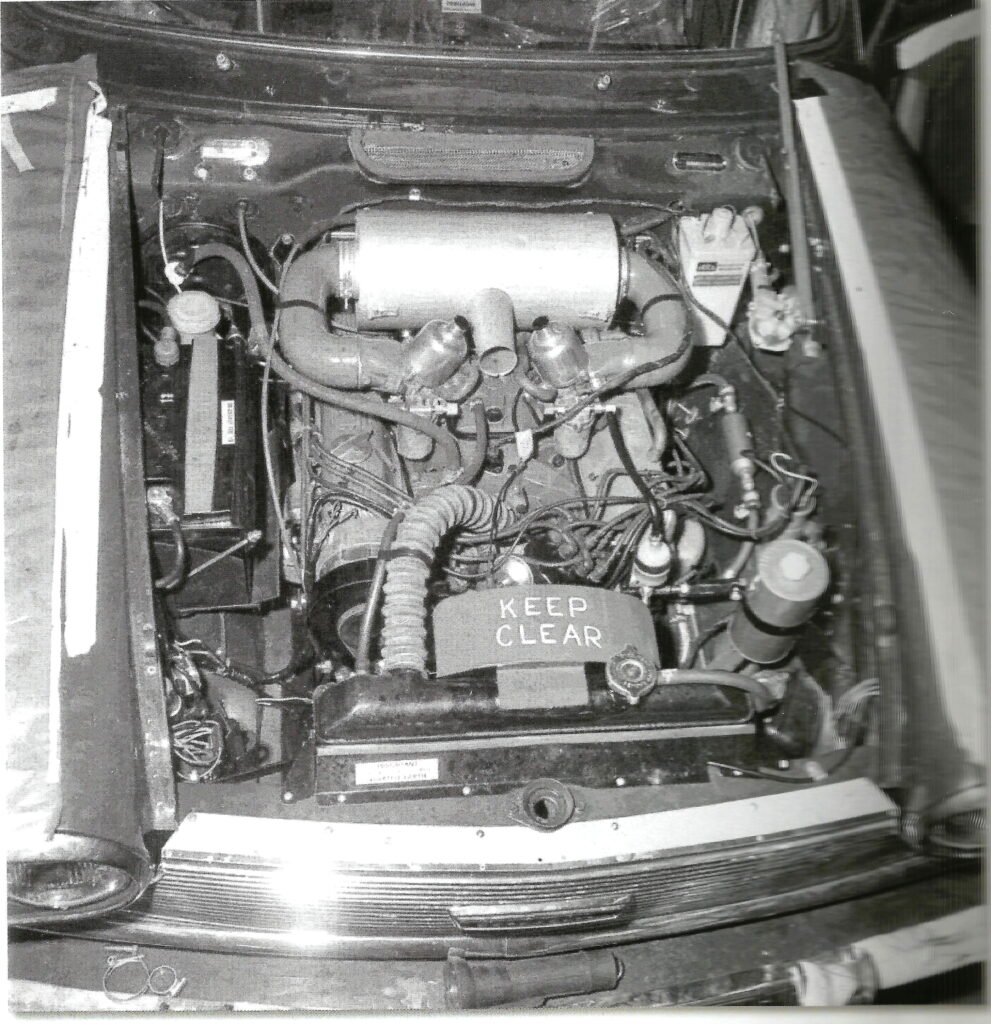
Austin 3 Litre Register of New Zealand
John Vevers and wife Louisa of Helensville have a collection of 3 Litre saloons along with a similarly powered 1968 MGC roadster.
“I’ve had the MGC since about 1985. It’s a left-hand-drive European specification model, which makes it a bit unusual. I won’t be changing it, and it’s always been a case of maintenance without doing it up, due to family expenses.”
It was their wedding car so it has a special place in their collection.
“The MGC was collected from the factory by its new Danish owner and then it was brought into New Zealand to Christchurch in 1970.”
Keeping the ‘C’ company is an ever-expanding collection of parts along with some very tidy Austin 3 Litre saloons. Their first Austin 3 Litre was bought as a source of parts for the ‘C’, and the collection grew from there.
“I keep on finding them. One was hiding in Marton and two others in Kaitaia; then there were two manual overdrive cars just south of Christchurch,” John explains.
John co-ordinates the Austin 3 Litre Register of New Zealand, currently with about 127 members and providing a repair and spare parts facility. Fortunately, a few parts are shared with various other Leyland models and John has a machine for repairing the hydrolastic suspension units.
Keeping the MGC company are three Austin 3 Litre saloons affectionately referred to as ‘Cherry’, ‘Old Blue’, and ‘Blackberry’.
Purchased in 2016 along with two spare C-Series engines, ‘Old Blue’ required some fettling but, after new spark plugs, a new distributor cap and ignition points, and a resetting of the timing after finding a distributor installed 180 degrees out, it fired up on the key for the first time in 18 months.
Louisa’s car, Cherry — CTZ396 in the photos — is the most recent 3 Litre in their collection, purchased in 2017. It is one of the last 700 cars off the production line in a run of some nearly 10,000 units in England.
“It’s fitted with a factory black-painted MGC-spec engine, giving a few extra horsepower through an MGC spec camshaft.”
The car sat in a barn in Taihape from 1985 to 2005. After its estate sale, it was restored by the new owner then went to another owner in Dannevirke, where John purchased it. The car required a lot of work to get it into its current condition, and had a mere 75,000 miles (120,000km) recorded.
“That was exactly one year after we had picked up our Blackberry car from Hastings.”
FI214 — Blackberry — was bought in 2016 from a Daimler Club member. It had been in Pukekohe for 22 years and in that time it had done just 22,000 miles [35,500km].” 16
The Vevers took the car to the Ellerslie Concours in 2017, where by chance it was reunited with the first owner’s granddaughter.
“The car now has 53,000 miles [85,000km] and I am just trying to keep it as original as possible.”
If you know of one of these interesting cars languishing somewhere, or you own one, then contact John: [email protected]



